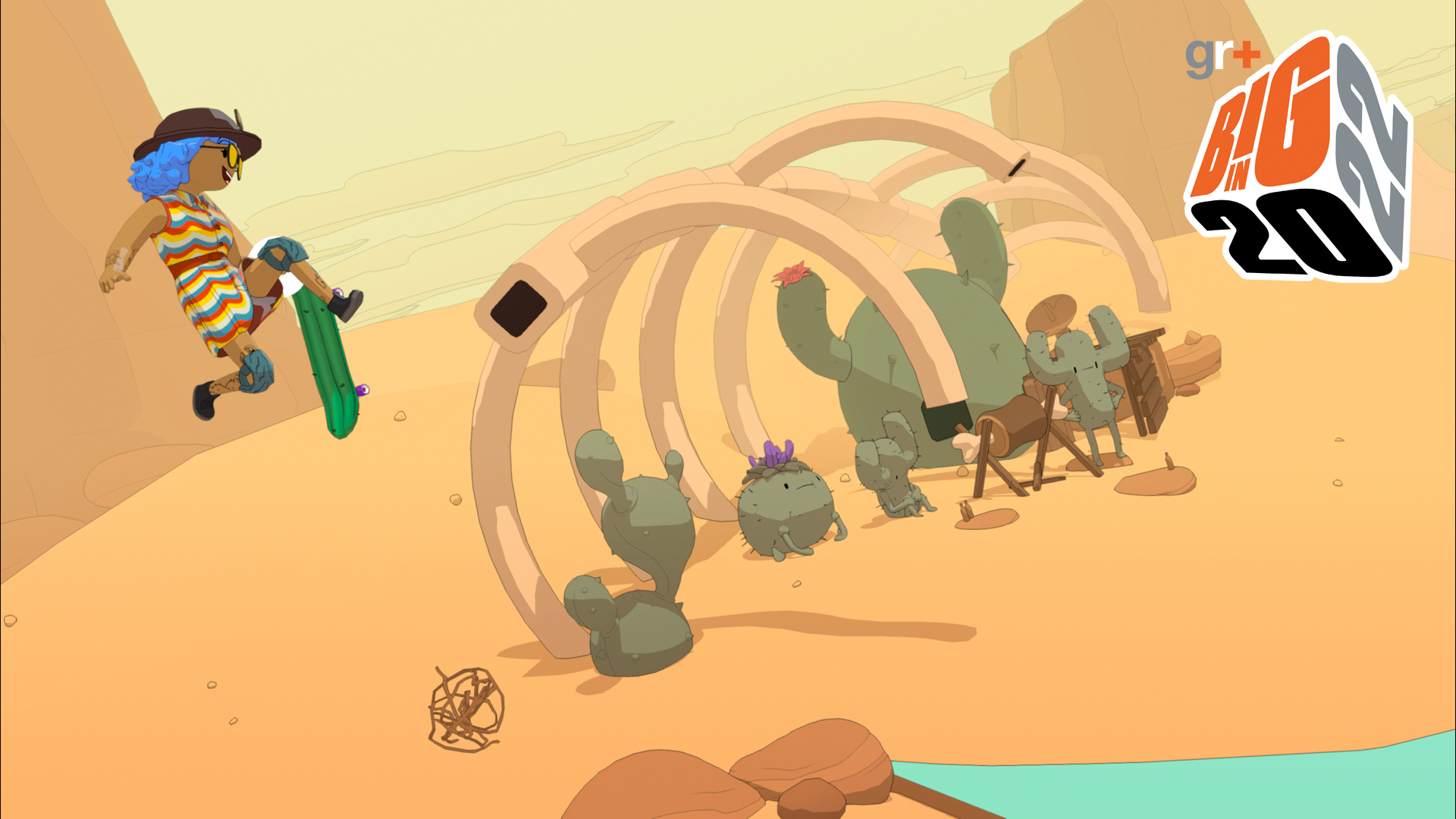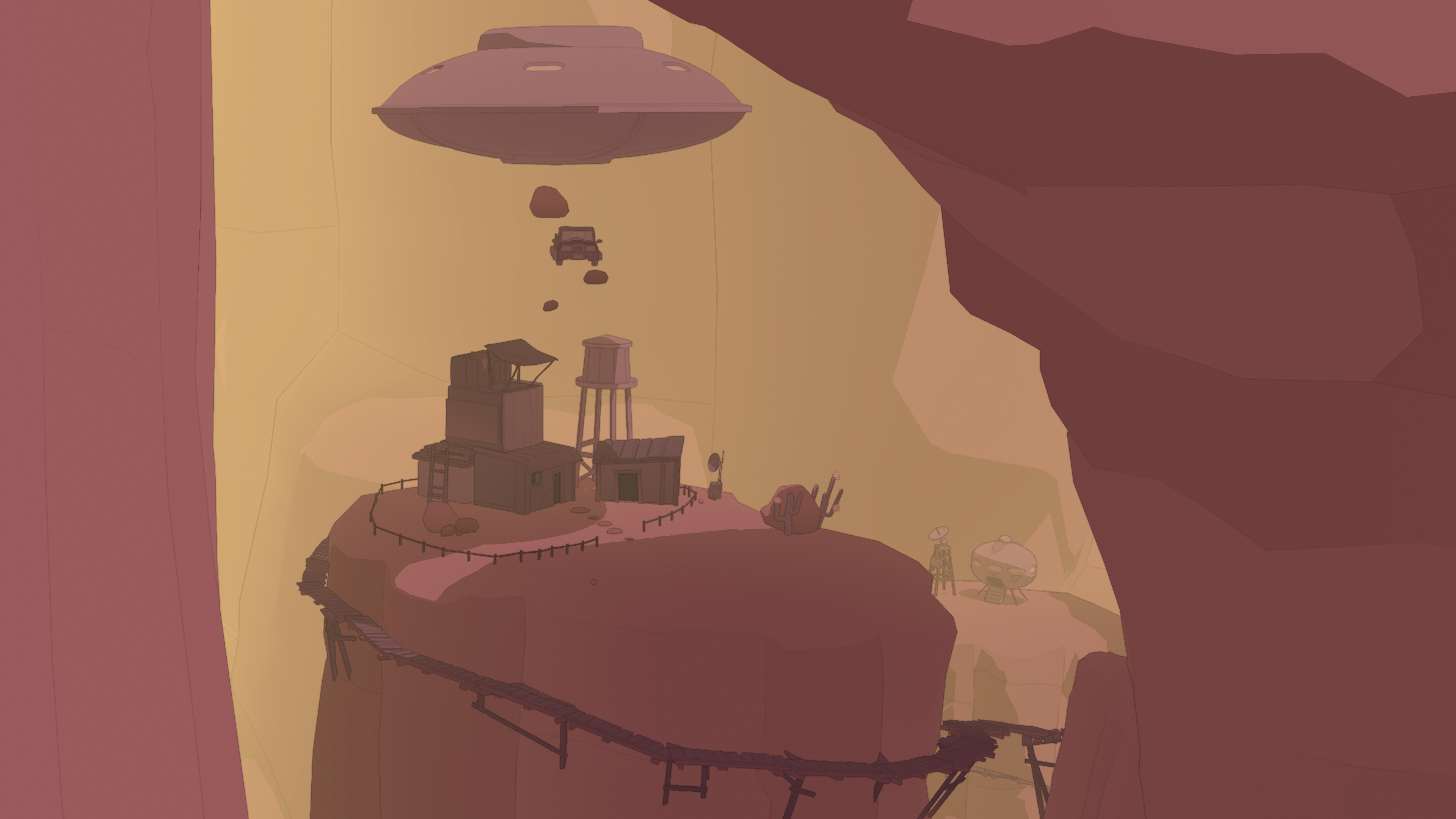
There is a bear in OlliOlli World who might be the actual devil. Like any good satanic soul, it cleverly obscures an evil nature by looking disarmingly cute. After all, who could hate a cartoon grizzly who rides down a rapid river in a rubber ring? Well, I can. That bear is my nemesis, a creature I pit my wits against for over an hour in one of the action platformer's many side-quests, and I just can't seem to beat him to the finish line. Until, that is, when everything comes together – my thumbs conducting a skating symphony. When I nail the final rail on the approach to the finish line to finally get the better of evil Baloo, I'm not too proud to admit that some air-punching was involved.
This right here is the magic of Roll7's latest, a game that inspires the same burning pursuit of mastery that only the best do. If you've ever spent red-eyed nights shaving off seconds in Burnout 3: Takedown, hunting for T-Spins in Tetris, or pummelling pals in Street Fighter 2, you'll understand why I spent so long trying to get the better of that bear. Because no matter the challenge, just finding the rhythm of a successful run is both entrancing and exhilarating in equal measure.
Under Control

Let's roll back a little, to before I was losing races to a giant bear in an inflatable. OlliOlli World is all about finding a "flow state". A skate odyssey that sees you navigating levels filled with gaps to air, rails to grind, walls to ride, and all manner of obstacles to clear that see how high a score you can rack up. If the series' not-so-secret sauce is providing that flow state – an almost meditative-like experience of focusing purely on hitting a perfect run – then OlliOlli World manages to improve on its predecessors with the use of PS5's DualSense controller to fully immerse you in the experience.
From the second you push off, you'll hear your board's wheels make subtly different sounds coming from the pad depending on the surface they're rolling across, such as the chatter they make when moving across the slates of the breezy boardwalks in Sunshine Valley or the smoother glide in the arid desert of Burntrock. There's also the haptic feedback as well, which uses shifting sensations in your hand to translate the feeling of landing a perfect grind or the balance of holding a manual. They combine to enhance the game's signature style, immersing you in the game's flow in ways that make the world of Radlandia almost tactile.
Talking to the team at Roll7, including Co-CEOs John Ribbins, Tom Hegarty, and Simon Bennett, the group explains how the DualSense features came about for OlliOlli World. Hegarty says: "It was definitely something we wanted to use. I think in the past, with kind of smaller teams, we never really had the opportunity to really use the features that the consoles have had available to us. So it's a really interesting challenge for the design and the audio team – actually, the audio that comes out of it was one of the team's later additions. But I think it's the one that I personally think works the best and really does add to the experience to make it a bit more immersive, and adds to the flow, which is always what we're trying to do."
Smells Like Skate Spirit


Of course, underpinning this all is the game's airy grooves that you can unlock throughout the game.
CO-CEO Simon Bennett explains: "I remember that my first implementation of the music unlocks was maybe a little bit more stingy. I think I went with something like 16 tracks base game, and then 16 tracks to be unlocked. And the feedback from people was like, 'man, I'm looping similar tracks, and I'm not getting the same [experience]'. So we kind of flipped some of the ratios and got to quite a nice point with it, where I think it's just like a couple per zone that you unlock."
Throughout the three distinct worlds I get to play for this preview, OlliOlli World demonstrates a leap forward for a series that has always kept a focused eye on its flow-state style. Firstly, there's the game's art design. It still boasts the vivid color that early entries had, but it now has the look of a lost Cartoon Network show, with distinctive characters and intricate backgrounds, such as the vast lakes of Cloverbrook or the buzzing seaside shine of Sunshine Valley, that give it a consistently arresting style as you fly through stages.
However, some of the bigger changes come to the game's structure. While there's still a focus on moving you from one level to the next, there are also side-quests and hidden levels for you to discover, which add breadth to the challenges that come your way and help you gain a greater understanding of the game's intricacies. Inside the levels are optional gnarly paths which add an element of puzzle to how you approach runs or tackle the game's optional objectives. The result is that everything around the core action has improved immensely without detracting or distracting from it.

Ribbins explains this design philosophy, telling me how exploration was one of the pillars of the game throughout development. "We wanted you to be able to explore the world and find cool stuff by going off the beaten track. And so that kind of tied into this idea of having side quest givers. That you can go off the beaten track, meet BD Hopper, and he's like 'Oh, we should go and do this other thing' which unlocks this other level."
One of those other levels is Grizzly Rapids, AKA the bear that now lives in my head rent-free and Ribbins continues about what they wanted those levels to achieve: "It doesn't necessarily require you to use core OlliOlli skills, but they're still trying to teach you. That one (Grizzly Rapids) is really teaching you about speed management, like, the way you win that level is by really understanding the power push mechanic, downhill grind, speed, and all that kind of stuff. It's not about combos, but they're definitely levels that, when you beat them, they will hopefully teach you some of the deeper mechanics. Or some of the stuff you've not necessarily actively thought about while you're playing the game, that may serve you really well through the rest of the main game."
Sign up to the GamesRadar+ Newsletter
Weekly digests, tales from the communities you love, and more
Searching for Gnarvana

If the game's single-player levels combine to create an utterly compulsive loop where you're testing yourself on the game's leaderboard, then the game's multiplayer offerings have the added incentive of letting you compare your skills against the rest of the community in both the Gnarvana League and Portal. They're both asynchronous, which means you'll be competing against friends and other players even if they're not on their console at the same time as you.
Both also offer something different depending on the type of player you are. The Gnarvana League is a daily competition that moves you up and down a league depending on how well you do and what type of streak you build up, giving you new cosmetics for your skater to deck themselves out in. It's clearly designed for those players who thrive on trying to climb a leaderboard and Ribbins tells us why the team decided to replace OlliOlli's daily challenge with the Gnarvana League: "Part of the overarching design philosophy for OlliOlli World was to be more welcoming and make a game that more people can play, make a game more people can enjoy. And so we kind of wanted that to be infused even into like the Gnarvana League stuff as well."

"So, by doing a thing where we break you down into smaller groups of people that you're playing against, it's not you competing against everyone else in the world, it's you competing against up to 10 others and so more people get to win. Basically, each day you're in a challenge, and there's a greater chance that you can come number one in your group and feel good about where you are in the game."
With the Portal, however, the game can generate a level that you can send onto friends to see who can set the highest score on it. Here, the focus is on a more casual style of play, where the challenge doesn't have to be as intense as the Gnarvana League, but it offers the same style of friendly competitiveness that can inspire the best runs. Plus, it also has the added bonus of being crossplay, which means your mates won't be able to hide from your scores (or vice versa!) by hopping to a different console.
Roll On

Both OlliOlli and OlliOlli 2 are cult favorites, games which demanded a lot from players' abilities and delivered blissful flow-state action in return for those persisted. However, when I ask what they're most excited for people to see in OlliOlli World, Ribbins deadpans "the end of the game" and explains: "Honestly, at the start [of this interview] you said what hundreds of people anecdotally said when they talked about OlliOlli 1 & 2, 'It was really good, kind of got a bit hard, and I kind of dropped off for about probably a second world'. And so to hear they've actually got through the first few zones [in World] and they did the side quest, that's music to our ears because from the start, we wanted to make an OlliOlli game that people see to the end. I hope that more people get to finish it, and hopefully those people are then inspired to go back and try some of the really hard stuff too, and they find that they enjoy that because they're better equipped to do it."
And, on the basis of the three worlds I've exhausted so far, it's hard to see how the team's wish won't come true. Like Burnout 3, this is the moment where everything comes together for the series in a way that feels irrefutably essential. The core flow-state action is the strongest it's ever been, while the world's art design is charmingly inviting. The level design is deliciously complex, with a soundtrack that helps soothe the pain of failing to beat a bear in a riverside race. I might have lost an hour to that, but it's going to be one of many lost to OlliOlli World as I make my way to its credits and then beyond them.
All throughout January, GamesRadar+ is exploring the biggest games of the new year with exclusive interviews, hands-on impressions, and in-depth editorials. For more, be sure to follow along with Big in 2022.

Ben Tyrer is a freelance games journalist with over ten years experience of writing about games. After graduating from Bournemouth University with a degree in multimedia journalism he's worked for Official PlayStation Magazine as a staff writer and games editor, as well as GamesRadar+ (hey, that's this website!) as a news editor. He's also contributed to Official Xbox Magazine, Edge, PC Gamer, GamesMaster, PC Games N, and more. His game of the year - no matter the year - is Rocket League.


